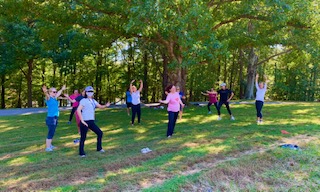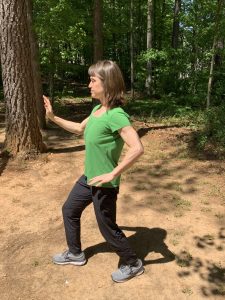 I watched my husband practice or "play" tai chi for several years before I was willing to give it a go. "That's too slow for me," I thought. "I won't be able to do it". Tai chi, originally a martial art, provides me with joy and I'm so glad I decided to try it! The movements, meditative aspects, and philosophy provide me with a gentle yet fierce option to soothe and nurture my mind, body, and spirit.
I watched my husband practice or "play" tai chi for several years before I was willing to give it a go. "That's too slow for me," I thought. "I won't be able to do it". Tai chi, originally a martial art, provides me with joy and I'm so glad I decided to try it! The movements, meditative aspects, and philosophy provide me with a gentle yet fierce option to soothe and nurture my mind, body, and spirit.
A bit of history…
Chinese medicine and Tai chi (ultimate of ultimate) have similar roots. Qigong (qi - life force; gong - practice, gather) reflects the inner aspects of Tai chi forms or the cultivation of bio-electrical energy. I like to think of qi as something like breath – we can’t see it but we know it’s there. Qigong is energetically based with focus on flow of energy in the body and allowing the body, mind and spirit to transform and heal.
There are more and more methods to measure and balance energetic fields as technology progresses over time. Its origins date back to the 6th century in China (some sources suggest much earlier) with teachings of Lao Tzu. People practice tai chi for various reasons - health benefits, martial arts, spiritual connection or all of the above. Specific postures combined into sequences/forms and adapted throughout the world for centuries make up much of modern Tai Chi. The Chen, Yang, Wu, and Sun styles are some of the most prevalent.
 Over the last few years, I’ve really enjoyed learning the movements of the Yang-style-24.
Over the last few years, I’ve really enjoyed learning the movements of the Yang-style-24.
It gives me a form to play with and move with ease and I can play without thinking about what is next. It’s soothing, offers me new perspective, and my energy improves during and after playtime 😊 The Tai Chi Quigong Shibashi set 1, another favorite, repeats 18 movements over and over again in the form. They movements specifically purge and tonify energy in different areas.
I asked some of my SAS Tai Chi play-mates to reflect about their experiences.
“When I first began practicing (or playing) Taiji, I became acutely aware of energies. I learned to pay attention to the energy flowing within my own body along the meridian pathway, the “energy ball” we often hold tenderly as we practice, and the energies as they move and exchange with fellow Taiji players and the people around us. When we’re ‘stuck’, the energy doesn’t flow; Taiji helps get us unstuck and bring us back to good health. These energies are exquisitely playful, delicate and beautiful.”
~ Annie Zangi, Sr Research Statistician Developer
“Tai chi can be viewed as a form of exercise, a martial art, or a spiritual practice. No matter how you view it, Tai Chi practice is beneficial. And, you can continue into your 90s.”
~ Bradley Jones, Distinguished Research Fellow
Ready to try out Tai Chi or learn more?
- SAS Employees and family are invited to join me on campus or Zoom for Tai Chi-Qigong for Calm Monday, Nov. 15, 12:15 – 12:45pm.
- Tai Chi in the RFC Video Gallery.
- Tai chi Foundation
- Qigong institute
- Tai Chi for Health Institute
- The Tao of Tai-chi chaun Way to Rejuvenation Jou, Tsung Hwa. 1980 Piscataway, NJ


